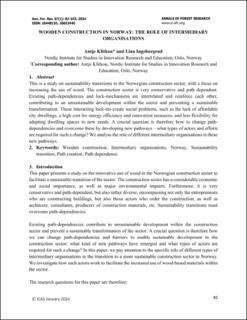Wooden construction in Norway: the role of intermediary organisations
Peer reviewed, Journal article
Published version
Permanent lenke
https://hdl.handle.net/11250/3117294Utgivelsesdato
2024Metadata
Vis full innførselSamlinger
Originalversjon
Annals of Forest Research. 2024, 67 (1), 82-103.Sammendrag
This is a study on sustainability transitions in the Norwegian construction sector, with a focus on increasing the use of wood. The construction sector is very conservative and path dependent. Existing path-dependencies and lock-mechanisms are interrelated and reinforce each other, contributing to an unsustainable development within the sector and preventing a sustainable transformation. These interacting lock-ins create social problems, such as the lack of affordable city dwellings, a high cost for energy efficiency and renovation measures, and less flexibility for adapting dwelling spaces to new needs. A crucial question is therefore how to change pathdependencies and overcome these by developing new pathways – what types of actors and efforts are required for such a change? We analyse the role of different intermediary organisations in these new pathways.
